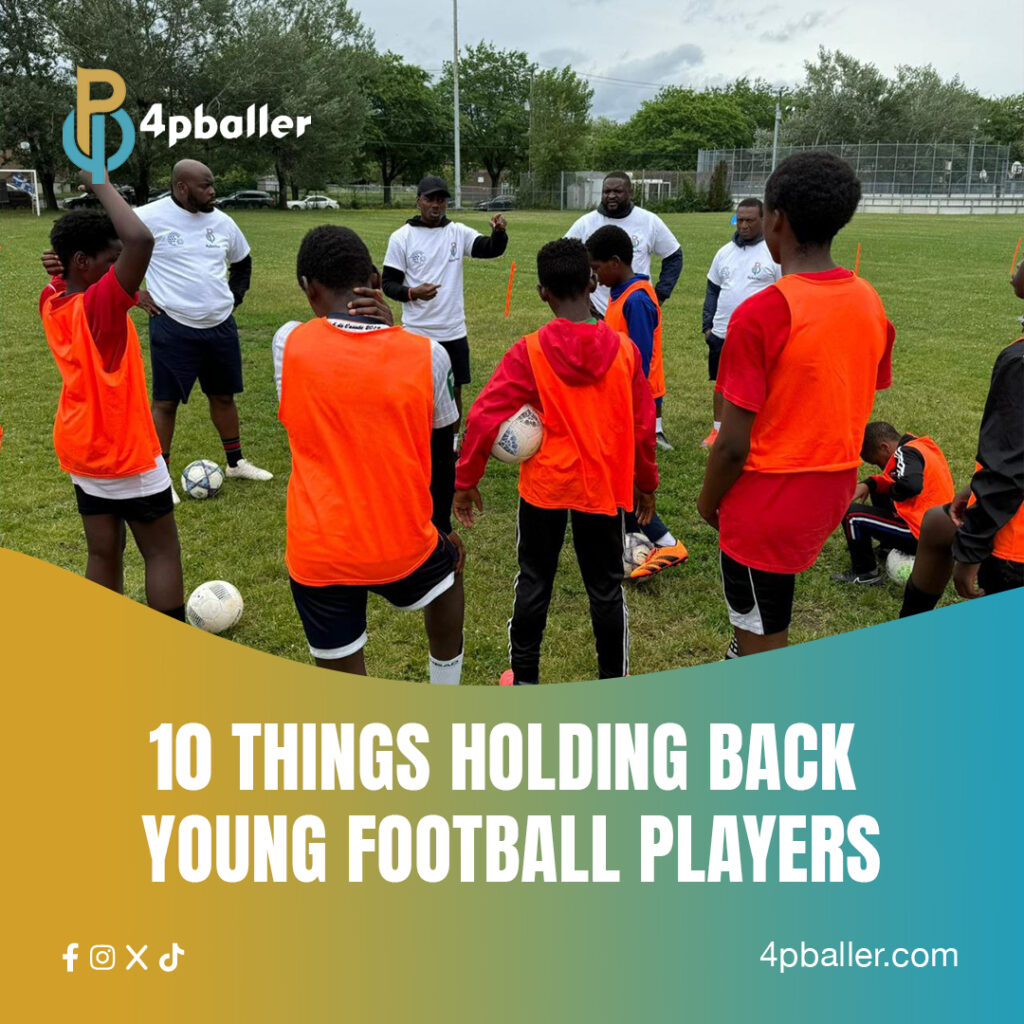Young footballers, brimming with talent and aspirations, often face a myriad of challenges that can hinder their progress. From inadequate coaching to mental health struggles, these obstacles can significantly impact their development and overall enjoyment of the game.
As a former footballer and someone who has worked with many young talents for many years, I’ve observed numerous factors that can impede a player’s development. Here are ten critical obstacles that young footballers face today:
1. Poor Technical Foundation
Many young players rush to learn advanced skills before mastering the basics. According to the UEFA Coaching Manual, the foundation skills of ball control, passing, and first touch should be prioritized until they become second nature. players should spend at least 60% of their technical training time on these foundational elements until they become automatic. Without these fundamentals, players hit a development ceiling quickly.
The foundation of football excellence lies in mastering the basics, yet this is where many young players falter. Here’s what I consistently observe:
- First Touch Deficiency: Many players can’t consistently control the ball with different body parts at varying speeds and heights. Practice should include:
- 100 touches minimum daily with each foot
- Varied surface contact (inside, outside, sole)
- Dynamic first touch drills with movement
- Passing Precision: Youth players often prioritize power over accuracy. Key focus areas should be:
- Short passing (5-15 meters) with both feet
- Weight of pass variations
- Passing under pressure scenarios
- Basic Ball Control: Essential skills are often rushed through:
- Receiving with different body parts
- Ball manipulation while moving
- Close control in tight spaces
2. Impatience with the Process
The “instant success” culture has created unrealistic expectations. Research from Sports Psychology Today shows that it takes approximately 10,000 hours of deliberate practice to achieve mastery in sports. Young players often become discouraged when they don’t see immediate results.
Modern football culture’s emphasis on early success creates unrealistic expectations. The development timeline needs understanding:
- Development Phases:
- Ages 8-12: Technical foundation building
- Ages 13-15: Tactical understanding introduction
- Ages 16-18: Position-specific specialization
- Common Misconceptions:
- Expecting professional contracts by age 15
- Comparing progress with social media highlights
- Rushing through development stages
Research shows that only 0.012% of youth players reach professional status before age 18. The focus should be on consistent improvement rather than rapid advancement.
3. Overemphasis on Game Time
While matches are important, many young players focus too heavily on game time rather than development. The German Football Association (DFB) recommends a 70-30 split between training and matches for optimal development.
The balance between training and matches is crucial. Here’s the optimal structure:
- Weekly Schedule Breakdown:
- 70% Technical training
- 20% Small-sided games
- 10% Full matches
- Quality Over Quantity:
- Focus on meaningful minutes
- Understand role and objectives
- Learn from both playing and observing
The German Football Association’s youth development model emphasizes that excessive match play can actually hinder technical development.
4. Physical Over-specialization
Early specialization in one position can limit overall development. Studies from the Journal of Sports Sciences show that players who experience multiple positions during their youth have better game understanding and adaptability.
A balanced approach includes:
- Multi-Position Experience:
- Rotate positions every few months
- Understand different tactical requirements
- Develop varied skill sets
- Physical Development Guidelines:
- Focus on coordination (ages 8-12)
- Introduce strength training (ages 13-15)
- Position-specific conditioning (ages 16+)
Studies show that players who play multiple positions until age 14 develop superior tactical understanding and adaptability.
5. Mental Health Neglect
The psychological aspect of football is often overlooked. According to FIFA’s Mental Health Research, young players who don’t develop mental resilience are 3x more likely to burnout before reaching their potential.
Essential focus areas include:
- Mental Skills Training:
- Confidence building exercises
- Pressure management techniques
- Goal-setting frameworks
- Support Systems:
- Regular psychological check-ins
- Team building activities
- Parent-coach communication
FIFA’s mental health research indicates that mental resilience training should comprise 25% of overall development time.
6. Technology Addiction
Modern technology, while beneficial for analysis and learning, can be detrimental when overused. Studies from the International Journal of Sports Science indicate that excessive screen time can reduce reaction times and spatial awareness on the field.
While technology can be beneficial, it needs careful management:
- Healthy Technology Use:
- Match analysis (30 minutes max daily)
- Skill learning videos (20 minutes max)
- Recovery monitoring apps
- Technology Boundaries:
- No phones 2 hours before sleep
- Limited social media during season
- Focus on real-time practice
Studies show that players who limit screen time to 2 hours daily show improved concentration and performance.
7. Inadequate Recovery Management
Young players often underestimate the importance of recovery. The International Olympic Committee consensus emphasizes that proper recovery is as crucial as training itself, particularly during growth spurts.
Proper recovery is crucial for long-term development:
- Recovery Protocol:
- Sleep: 8-10 hours nightly
- Nutrition: Post-training refueling
- Active recovery: Light movement on rest days
- Monitoring Systems:
- Training load tracking
- Sleep quality assessment
- Fatigue indicators
The IOC emphasizes that youth players need 30% more recovery time than adults due to growth and development factors.
8. Poor Communication Skills
Many talented players struggle to express themselves effectively on and off the field. UEFA’s Youth Development Reports highlight that players with better communication skills are more likely to succeed in team environments.
Effective communication impacts all aspects of development:
- On-Field Communication:
- Clear, concise calls
- Non-verbal cues
- Leadership vocabulary
- Off-Field Communication:
- Coach-player feedback sessions
- Team strategy discussions
- Conflict resolution skills
UEFA research shows that players with strong communication skills are 60% more likely to be selected for advanced programs.
9. Lack of Game Intelligence
Focus on physical attributes often overshadows tactical understanding. According to Barcelona’s La Masia methodology, developing game intelligence through situational training is crucial for long-term success.
Tactical understanding is as important as technical skills:
- Tactical Development Areas:
- Reading the game
- Decision-making speed
- Spatial awareness
- Training Methods:
- Small-sided games with constraints
- Video analysis sessions
- Tactical board work
Barcelona’s La Masia emphasizes that tactical intelligence should be developed alongside technical skills from age 8 onwards.
10. Environmental Distractions
The modern youth environment presents numerous distractions. Research from Sports Medicine shows that players who maintain a focused, disciplined lifestyle are 40% more likely to reach professional levels.
Managing external influences is crucial for focused development:
- Common Distractions:
- Social pressures
- Academic demands
- External activities
- Management Strategies:
- Time management training
- Priority setting
- Support system development
Research indicates that players with structured environments are 40% more likely to achieve their development goals.
Implementation Strategy
To address these challenges effectively:
- Assessment: Evaluate current status in each area
- Prioritization: Focus on most critical areas first
- Action Plan: Create specific, measurable goals
- Monitoring: Track progress regularly
- Adjustment: Modify approach based on results
Conclusion
In conclusion, by addressing these challenges, young footballers can maximize their potential and achieve their dreams. It’s crucial for parents, coaches, and players themselves to recognize these factors and take proactive steps to overcome them. With the right support, dedication, and a positive mindset, young footballers can flourish and reach new heights in the beautiful game.

